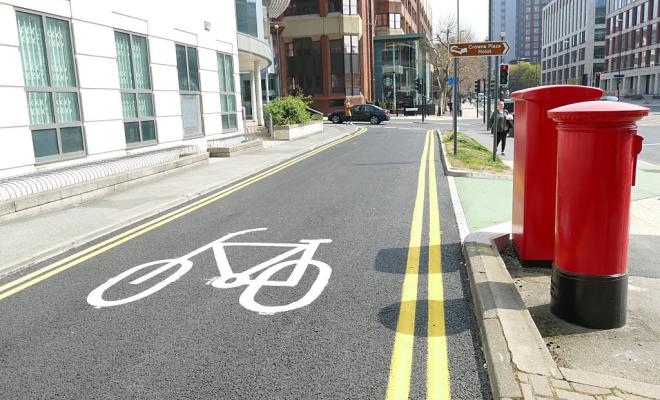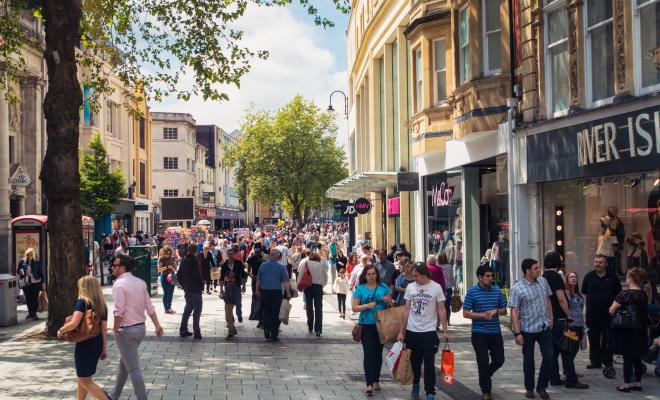09 Nov 2023
Councils and climate justice
We need to keep up the pressure to cut emissions, but some climate impacts – like flooding, intense heat and water shortages – are already inevitable and are already being experienced by people first-hand.
Across the UK, and the world, the effects of the climate crisis are experienced differently by different communities. For example, in the UK, flooding caused by climate breakdown often has a worse impact on lower income households that can't afford to make their homes flood-resistant. Another example of inequality is that people of colour are 4 times more likely to live in areas at high risk of dangerous levels of heat during heatwaves. And poorer countries around the world usually bear the brunt of climate impacts such as rising sea levels and drought, despite having done the least to contribute towards global emissions.
Central to climate justice is an understanding that those who've done the least to cause climate breakdown are the ones who suffer the worst of its effects.
Climate justice also means ensuring no-one is left behind as we transition to a low-carbon future. Everyone should be able to heat their home, enjoy access to nature and have a good quality of life. And those who were previously working in fossil fuel sectors and carbon-intensive jobs should have access to the training and re-skilling needed to work in a low-carbon economy.
Councils must therefore make sure that their Climate Action Plans are ambitious enough and are delivered with, and for, those most impacted by the effects of climate change. This involves:
1. Identifying the most at-risk people in neighbourhoods that are susceptible to extreme weather events and fuel poverty, and with the least good-quality green space – and targeting policies and spending to support these people and areas.
There’s information available to help councils – for example, Friends of the Earth has identified nearly 9,000 energy crisis hotspots where communities are most impacted by spiralling energy prices. Similarly, researchers at Manchester University have identified:
- the neighbourhoods in England and Wales where there’s a very high, acute or extreme social flood risk to surface, coastal or river flooding. High social flood risk means neighbourhoods that are both vulnerable to flooding and also have a high proportion of people less able to prepare for or recover from extreme weather events.
- which communities in the UK are most socially vulnerable to the health impacts of heatwaves because of where they live and the make-up of the local population.
Councils can use this information to help people prepare for extreme events, to support them to recover afterwards, and to target action to make these areas more resilient to extreme weather and rising energy prices in the future.
2. Listening to the voices of those most impacted by the climate crisis and ensuring they’re represented in council decision making and consultations.
Councils need to hear and consider the voices of all their citizens when making decisions, but the voices of the most vulnerable to climate change are often overlooked or drowned out. Ensuring these voices are heard doesn’t just mean making decision-making processes fair and inclusive, but also investing long-term in supporting marginalised people to increase their participation. For example, Hull City Council has ensured the opinions of vulnerable communities were used to help co-design much-needed flood defences in the city.
Global climate justice
Council action on climate justice shouldn’t stop at the local. Global climate justice requires that the UK contributes a fair share of emissions cuts globally, so local Climate Action Plans will need to achieve deep cuts over the next 10 years. Emissions related to imports aren’t included in the UK’s reduction targets, but imports of food, timber and other commodities are causes of deforestation in the global south and can be linked to human rights abuses.
Councils should consider how they can reduce the overseas impact of their purchasing through their procurement contracts. For example, reducing meat and dairy products in schools, colleges and care homes, as well as sourcing fresh, locally grown produce and pasture-fed meat and dairy would help reduce the impact of imported meat and animal feeds (see Action 44 of the 50-point Plan). Councils can also help with raising awareness among their residents about the social and environmental impacts of the products they buy.
The target
Councils need to show ambition on a par with the climate and cost-of-living crises. With existing resourcing and powers, a reasonable target for councils to aim for is:
To ensure that those most impacted by the effects of climate change are properly supported and are represented in council decision making.
Challenges
The coronavirus pandemic, followed by the cost-of-living crisis, has worsened inequalities across the UK, impacting on things like health, educational outcomes, and ability to cope with extreme cold or hot weather. It’s more important than ever that justice is a consistent consideration throughout council Climate Action Plans to ensure a fair transition to a low-carbon society and reduce inequalities. This’ll require councils to have staff and councillors who are properly informed on justice issues and who are able to bring climate justice into their decision making.
For example, councils need to consider how their approach to cutting transport emissions will impact and benefit people who don’t have access to a car – something that's much more prevalent among lower income households. This means that, while encouraging the switch to electric vehicles is an important part of cutting emissions, a justice-based approach also requires improvements to public transport and active travel to ensure that key services as well as social and work opportunities are accessible to those without a car.
Climate adaptation and resilience measures like flood defences and shading to protect from overheating aren’t yet well embedded into councils’ Climate Action Plans, and so are far from being integrated across the many functions of a council. A review of council climate action by the Place-based Climate Action Network (PCAN) found that fewer action plans contained measures for adaptation compared with mitigation, and that adaptation was mentioned in fewer than 12% of climate emergency declarations.
Councils leading the way
Some councils are already making strides to engage with and target action at communities that are vulnerable to the impacts of climate change, and to take a more justice-based approach to climate action. Share these examples with your council using this template email and help inspire them to take action.
Dundee City Council is identifying those residents most at risk of extreme weather events and fuel poverty and targeting support at these groups. The council has calculated that 31% of the city’s households are affected by fuel poverty, which is above the Scottish national average. The city’s location also leaves it vulnerable to extreme, unpredictable weather events such as flooding.
Hull City Council is working to build community resilience to flooding events by co-designing defence measures – such as sustainable drainage systems – with the community and engaging with people whose homes are at risk of flooding.
Hampshire County Council is the only council so far to have set a climate resilience target and has developed decision-making tools to embed climate resilience into all decision making. This means putting in place measures that'll help prepare the local area to deal with climate impacts that are already inevitable, such as flooding and extreme heat. The council is working with the Environment Agency to look at property-level adaptation and improve the resilience of individual homes, with previous flood events being used to help target the most vulnerable residents.
For examples of councils leading the way on tackling fuel poverty, see our guide on homes and buildings.
Councils also need to think creatively about how to engage people and communities on an ongoing and long-term basis. Brent Council prioritised “supporting communities” in its climate strategy. It appointed climate ambassadors from faith communities to work locally to create Green Neighbourhoods. Via an existing multi-faith forum, the council also brought together a group of 11 local religious leaders, who had pictures taken by a local photographer and shared their perspectives on the climate emergency. A free exhibition was then displayed at the civic centre and faith buildings looking at how faith can influence how we act on climate, drawing on scripture and stories from those faiths. The council has continued to work with local faith leaders, who can engage positively with their communities about climate-related behaviour changes.
Learn from others
Some groups have already been working within their communities to raise awareness of climate justice. For example, Friends of the Earth Neath Port Talbot has highlighted the disproportionate impact of extreme weather on certain groups such as people of colour and those on lower incomes. It secured local media coverage during a period of extreme heat in 2022, which helped raise awareness locally of the damaging health impacts of the heatwaves and the need for local and national governments to support those groups most vulnerable to the heat. Raising awareness in this way is a great first step to making sure your council prioritises climate and social justice in its Climate Action Plan.
Convince your council
One of the best ways you can make sure your council is supporting and listening to those most vulnerable to the effects of climate change is by ensuring your group is diverse and works with local allies who represent these communities. The stronger and more representative of the local community your group is, the more likely your council is to listen. Building alliances with local organisations such as fuel poverty action groups or anti-racist campaign groups will also help make sure that your campaign is centring the voices of those most impacted by the climate crisis. This’ll help ensure your council’s plan is delivered with, and for, the whole community. Find out more about how to build local alliances.
Good community engagement will also help the council to deliver on its plans – many climate actions will involve behavioural changes that need people to come on board, and stretched council budgets mean that community partnerships are all the more important to delivery.
Councils are more amenable to introducing schemes that have a wide array of benefits, as it generally means they’re more cost effective – which is more important than ever due to dwindling council budgets. If you’re in contact with your council about climate justice, make sure to highlight the co-benefits of better community engagement and climate action that takes a justice-based approach. These include:
Low-carbon jobs. There's a huge opportunity to help reskill people who are currently employed in high-carbon sectors. For example, 360,000 people work in carbon-intensive sectors in Yorkshire & Humber and will be affected by the low-carbon transition. Reskilling people will help enable the shift to a low-carbon economy while at the same time making sure these workers aren’t left behind.
Health. Councils often find that framing climate action in terms of health benefits helps get local people on board by making them more likely to be engaged in plans and more accepting of the changes that acting on climate will bring to their lives.
Nature-rich green space contributes to more resilient places, for example trees can provide shade in extreme heat and some green spaces can help prevent flooding. Access to quality green space is also important for our wellbeing and contributes to better physical and mental health, so a justice-based approach would ensure everyone has good access. In Hackney, about three-quarters of residents don’t have a private garden – making access to public green spaces even more important. Hackney Council is working to make green spaces available to everyone, regardless of their situation, particularly the many Hackney residents who live in rented accommodation and on estates.
Another health benefit of climate justice comes from addressing fuel poverty – not only does improving energy efficiency in homes help cut emissions, but it also tackles the negative health impacts of not being able to heat your home properly, often suffered by lower income households. Find out more about fighting fuel poverty in our homes and buildings guide.
Funding and powers
Action by central government will empower councils to do more. Councils can and are acting now, but it’s hard to find a council able to act across all the areas they need to and at the scale and pace commensurate to the climate and ecological emergencies. For example, although many climate adaptation programmes will save councils money in the long run, many have been neglecting these areas due to a lack of funding. That’s why they need additional powers and resources. Central government can help by:
- Committing an extra £1 billion a year of investment into extreme weather protection. This includes money for natural flood defences, such as tree planting in the uplands to hold back flood water, and for more trees in urban areas to provide cooling during extreme heat.
- Ensuring that regulations on issues such as building standards are adequate to protect against future extreme weather.
Alarmingly, the government’s own advisor, the Climate Change Committee (CCC), has found that the gap between the level of risk we face and the level of adaptation underway has widened. Adaptation action has failed to keep pace with the worsening reality of climate risks.
Climate justice should be embedded across all aspects of Climate Action Plans, and this is reflected in our calls on government for more funding and powers across issues such as transport and homes.
Friends of the Earth has joined local government organisations, academics and other NGOs in setting out a Blueprint of what’s needed from national government to support councils in key policy areas, including adaptation and a fair transition to a low-carbon economy. The coalition has assessed how the government is doing so far in its progress tracker. Be sure to ask your council to sign up to the Blueprint if it hasn't done so already.
Helpful resources
Find out what progress your local area has already made on this topic with our handy data tool, “Near you”.
Watch our training video to find out how your council can prioritise climate justice when developing and delivering its Climate Action Plan:
Read more about what we mean by climate justice and why it’s important to your campaign.
Find out more about who’s most vulnerable to the impacts of climate change and why.
Want to delve a bit deeper? This climate justice reading list is a good place to start.
Find out how you can build a strong campaign to push your council to take ambitious action in this area.
Read more examples of best practice by councils.
Find out how your council is doing by looking at its Council Climate Action Scorecard, created by Climate Emergency UK.
Watch this video on how Brent Council engaged with faith communities on climate action.



